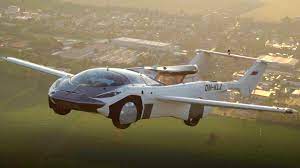COURTESY : physicstoday.scitation.org
Flying car
The flying car remains the poster child for technology’s failure to deliver a future akin to ones depicted in postwar science fiction. In fact, flying cars have been feasible for decades. Regulation and cost have kept them out of the marketplace. But as Gregory Keoleian of the University of Michigan and colleagues point out in a new paper, a technology known as distributed electric propulsion (DEP) has brought flying cars within reach.
DEP entails equipping a flying car, or more generally, a vertical takeoff and landing aircraft (VTOL), with four or more modestly sized motors that drive rotors. Several DEP-powered airframe configurations are under development, including NASA’s GL-10, shown here. DEP is aerodynamically efficient, while the use of an electric power train reduces the emission of greenhouse gases. Yet getting aloft—that is, doing work against gravity and air resistance—remains energetically costly.
With those tradeoffs in mind, Keoleian and his colleagues set themselves a question: Under what circumstances could VTOL travel in air be more environmentally friendly than automobile travel on roads? The question is more subtle than it might first appear. One advantage that VTOLs have over cars is the ability to travel directly from point to point. Cars use road networks. In towns and cities, routes are seldom direct or free of traffic. Another factor is duration of trip. The longer a VTOL trip, the smaller the fraction of time a VTOL spends on energy-intensive climbing and hovering. More specific factors include wind speed, the carbon intensity of the local grid, the number of passengers, and the mass and specific energy of batteries.
The researchers first considered a direct, point-to-point trip of 100 km with a single occupant. For that base case, a VTOL emits 28% more greenhouse gases than an electric car does and 35% less greenhouse gases than a gasoline-powered vehicle does. Having developed their model, Keoleian and his colleagues conducted a sensitivity analysis, which identified a case when a VTOL’s travel also could be greener than an electric car’s: For long-distance trips of 100 km or more, an air taxi with one pilot and three passengers would emit less greenhouse gas per passenger-mile than a car with the national average of 1.54 occupants. They write, “VTOLs offer fast, predictable transportation and could have a niche role in sustainable mobility.” (A. Kasliwal et al., Nat. Commun. 10, 1555, 2019.)



